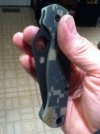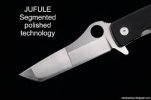Just look how S30V soars up
the Ankerson rope cutting chart with a little geometry change (and maybe a touch harder but only half a point or so) and the Military is no slouch right:
. . . and above S110V . . .

WHAAAAAAAAAAAAAA ?


. . . . . .
S30V - 620 - Michael Raymond Estrella Custom - 60.5 - 61 RC -
.006" behind the edge
S110V - 600 - Mule - 60 RC - .015" -.018" behind the edge.
S90V - 600 - Benchmade 940-1 - 59-61 RC - .018" Behind the edge.
S35VN - 560 - Fiddleback Forge Kephart - 60-61 RC - .015" Behind the Edge.
CTS-XHP - 540 - Cold Steel Ultimate Hunter - 63.5 RC - .020" behind the edge
CPM M4 - 500 - Spyderco Gayle Bradley - 62.5 - .022" behind the edge
S90V - 460 - Military - 60 RC
S90V/CPM 154 - Para 2 - 460 - ? RC
White Steel Laminate - 460 - HSC Custom - 63-64 HRC - .020" behind the edge
RWL-34 - Mule Team 22 - 440 - 61-62 RC - .020" Behind the edge
CTS 204P - 420 - Para 2
ZDP -189 - 420 - Endura 4 - 65 RC
Niolox - 420 - LX Blades - 59 - 59.5 RC - .006" behind the edge
BD1N - 420 - Phil Wilson - 60 HRC - .020" behind the edge
M390 - 400 - Benchmade 810-1401 Contego 60-62 RC
M390 - 380 - Military - 61 RC
ELMAX - 340 - ZT 0770CF - ? RC
ELMAX - 340 - Para 2 - ? RC
AEB-L - 340 - Tim Johnson Custom - 60 RC - .006" behind the edge
HAP-40 - 320 - Spyderco Endura - ? RC - .024" behind the edge
S35VN - 320 - Chris Reeve Sebenza 25 - ? RC - .021" behind the edge
CruForgeV - 300 - Bluntcut Custom - 62 HRC - .012" behind the edge
S30V - 300 - Military - 60 RC
. . . . . .




